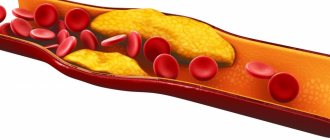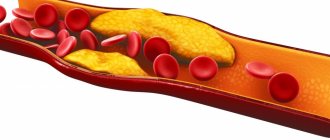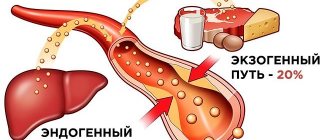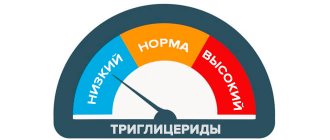Cholesterol and its participation in the development of atherosclerosis are written about everywhere, except perhaps only in children's literature. Even vegetable oil manufacturers (for advertising purposes), on their packaging materials o. Although, a priori, cholesterol is not found in fats of plant origin. Without pretending to be a deep scientific article with the publication of chemical formulas, etc., I want to organize various data and make them understandable to all people, and not just doctors or pathophysiologists.
What is cholesterol?
Cholesterol (CS) is a substance related to lipids (lipos - fat), and according to its chemical structure, cholesterol is classified as a steroid. The group of lipids includes: neutral fats (glycerides), fatty acids, phospholipids. Together with phospholipids, cholesterol is part of cell membranes and is a building material, especially of the nervous system. Cholesterol is a substance necessary for the normal functioning of the body. Once again I want to emphasize - for the normal functioning of the body! Without cholesterol, our body cannot function properly. Cholesterol is the source of the formation of bile acids, steroid and sex hormones. Most human tissues have the ability to synthesize cholesterol, but most of it is synthesized in the liver. There is a constant exchange of cholesterol between the liver, blood plasma and tissues.
Since cholesterol and triglycerides are insoluble in water (as is known, fat is not soluble in water), and accordingly in the blood plasma, they enter into a complex with proteins and among themselves, forming transport forms of lipoproteins intended for transfer to disposal sites. Based on molecular size, there are 4 main classes of lipoproteins: chylomicrons, very low-density lipoproteins (VLDL), low-density lipoproteins (LDL), and high-density lipoproteins (HDL). Each of these lipoproteins contains varying amounts of cholesterol, proteins, triglycerides and phospholipids.
A person not only synthesizes cholesterol himself, but also receives it from non-plant foods. I'm talking about food that is not of plant origin. The fact is that cholesterol is found not only in animal products, but also in seafood!
3.What factors affect cholesterol levels and cholesterol levels?
A variety of factors can affect your body's cholesterol levels, including:
- Diet
. The foods you eat that are rich in fat and cholesterol also increase the level of cholesterol in your body. Therefore, it is not recommended to eat a lot of foods containing cholesterol. - Weight
. Being overweight is a risk factor not only for heart disease, but also for high cholesterol. - Physical exercise
. Regular exercise helps lower bad cholesterol and increase good cholesterol in the blood. - Gender and age
. The older a person is, the higher his cholesterol level. Women before menopause tend to have lower cholesterol levels than men of the same age. But after menopause, bad cholesterol tends to increase in women. - Diabetes
. If diabetes is not controlled, cholesterol levels in the body also increase. - Heredity
. Genes partly determine how much cholesterol your body produces. The tendency to have high cholesterol is often inherited. - Other reasons
. Some medications and medical procedures can cause an increase in blood cholesterol levels.
Normal cholesterol level in the body
It is recommended that all people over 20 years of age have their cholesterol levels checked at least every five years.
During testing, only the level of good cholesterol in the body can be checked, or a complete lipoprotein analysis
, which measures both good and bad cholesterol and total cholesterol and triglycerides in the body.
In general, a total cholesterol level below 200 is considered optimal. The range of 200-239 is the upper acceptable limit of normal. A cholesterol level of 240 or higher is already high cholesterol.
.
About our clinic Chistye Prudy metro station Medintercom page!
What foods contain cholesterol?
Therapists, cardiologists, neurologists are those doctors who most often encounter problems with high cholesterol (hypercholesterolemia) and disorders of blood lipid composition (dyslepidemia), and, accordingly, atherosclerosis. These experts unanimously say that you should not eat pork, lard, butter and other products containing fat, as well as eggs.
Let's figure out whether only fatty foods and eggs are the main supplier of cholesterol. To do this, let's look at the table.
The recommended intake of cholesterol per day is 300 mg, but in many products it is found in such quantities that it is almost impossible to comply with it without looking at the table. This data will help you not to suffer from excess weight and not have problems with coronary heart disease.
According to the table, we see that in liver, beef tongue, capelin, shrimp, fish caviar, carp, the cholesterol content is higher than in pork and pork fat! And the highest cholesterol content is in beef brains (remember that cholesterol is the building material of the nervous system?). It is very important to say here that the level of cholesterol in the blood is 65-75% due to liver synthesis, and 25-35% due to dietary intake.
How to treat high cholesterol
To reduce LDL levels, it is important to address the cause of high cholesterol and any predisposing factors. First, you should do a lipid profile. The examination shows how serious the increase is . High cholesterol is treated by a general practitioner or cardiologist. There is also a more specialized specialist - a lipidologist.
To reduce high cholesterol levels in the body, you must adhere to the following recommendations:
- Follow a diet. Namely, reduce the consumption of animal fats, “fast” carbohydrates, and foods with trans fats. Nutritional correction reduces LDL levels by 10-15%.
- To refuse from bad habits. Moreover, not only active smoking, but also passive smoking is detrimental to health.
- To live an active lifestyle. It is useful to walk in the fresh air and set aside time for physical exercise. Exercise for at least 30-60 minutes. in a day.
- Control your weight. Fat deposits in the abdominal area are especially dangerous.
- Control blood sugar levels. This recommendation applies to patients with diabetes, as well as people who are predisposed to this disease.
- Cure endocrine diseases, normalize hormonal levels.
Sometimes statins are needed to treat high cholesterol. They produce an immediate effect, but scientists are increasingly talking about their shortcomings. Drugs in this group do not have a selective effect, they reduce everything - both “bad” and “good” cholesterol, and also negatively affect the functioning of the liver. However, their harm is less than the complications of critically high LDL levels.
Formation of atherosclerosis by cholesterol
Atherosclerosis is a multifactorial disease of the cardiovascular system with predominant damage to medium and large arteries.
Cholesterol is secreted from the liver with bile in the composition of bile acids, which are 70–90% absorbed in the small intestine and enter the liver, where cholesterol is synthesized from them again. Thus, cholesterol metabolism is a finely regulated system. Excess intake of cholesterol from food is compensated by a decrease in absorption in the intestine, as well as a decrease in synthesis in the liver. If the amount of cholesterol in food decreases, the reverse process occurs - its synthesis in the liver increases and absorption in the small intestine increases. Therefore, the level of cholesterol in the blood is a stable indicator until a failure occurs - a violation of these processes
High-density lipoproteins (HDL) prevent the deposition of cholesterol in blood vessels, and even remove already deposited cholesterol from the vessel wall, sending it for further utilization in the liver. These lipoproteins prevent the formation of atherosclerosis. Low-density lipoproteins (LDL) and very low-density lipoproteins (VLDL) contribute to the formation of atherosclerosis.
Thus, the higher the content of LDL and VLDL, the higher the risk of developing atherosclerosis. The higher the HDL level, the better.
The atherogenicity index (the risk of developing atherosclerosis) can be calculated using the formula: K = Total cholesterol - HDL / HDL, where Total cholesterol is the total cholesterol content in the blood plasma. HDL is the content of high-density lipoproteins in blood plasma. Normal: K = 3-3.5.
The lower this ratio, the better. Standard indicators of lipoproteins in blood plasma are presented in the table. According to European data, LDL should be less than 3.0 mmol/l (Wood D. Et al. Eur. Heart J., 1998).
So why does the failure occur, why does the cholesterol metabolism occur? These mechanisms are very complex and not fully understood. It is known that among a number of peoples of the Far North, where the main foods are venison and fish, atherosclerosis is rare. And at the same time, vegetarians can have high levels of cholesterol and LDL in the blood! Increased cholesterol levels may be due to hereditary factors: heterozygous or homozygous familial hypercholesterolemia. However, many scientific data prove that high levels of cholesterol and LDL, among others, are not always an absolutely reliable sign of the development of atherosclerosis. It is also interesting that there is a certain mosaic pattern of vascular lesions, i.e. plaques form in certain areas. A reasonable question arises: why does atherosclerosis form here, and not elsewhere in the vessel?
As already mentioned, atherosclerosis is a multifactorial disease. Significantly in the formation of a plaque in a certain place of the vessel, damage to the wall of the vessel itself contributes. Risk factors for the development of vascular damage and the development of atherosclerosis are as follows:
- Hypercholesterolemia and dyslipidemia.
- Smoking.
- High blood pressure.
- Stress.
- Diabetes.
- Decreased physical activity.
- Age and gender.
These and other risk factors lead to damage to the integrity of the vascular wall, where lipoproteins, fibrin, platelets, and calcium are deposited, which forms an atherosclerotic plaque.
In people who smoke, atherosclerosis develops 2-3 times faster than in non-smokers. Smokers also experience an increase in affected blood vessels.
An increase in blood pressure increases the risk of coronary heart disease by more than 3 times at any level of cholesterol in the blood plasma. In a random selection of Muscovite men aged 40-59 years over 6 years, the percentage of deaths from diseases associated with atherosclerosis was 5 times greater with a combination of dyslipoproteinemia and arterial hypertension than with the presence of one of these factors (Oganov R.G., Zhukovsky G. .S., 1987). More than one million people die in the world from cardiovascular diseases, of which almost half a million from coronary heart disease and 300,000 from cerebral vascular pathology - strokes, etc. (Kukarchuk V.V., 2006). The basis of these diseases is atherosclerotic damage to the arteries of the myocardium and brain. In Russia, mortality from coronary heart disease is one of the first places. The maximum incidence of the disease occurs at the age of 40-50 years (Parfenov A.S., 2006). Hypertension in Russia affects 39.9% of men and 41.1% of women (Kotov S.V., 2006).
Emotional stress leads to neurohumoral changes that increase vascular permeability and facilitate their infiltration of lipids.
However, cerebrovascular accidents are also observed in children. In the structure of childhood neurological pathology, they range from 3-5% to 8 - 10% (Badalyan L.O., 1984; Troshin V.M., 1996; Banker Q., 1992). And children also have strokes. Yes, yes, exactly strokes! In 83% of cases, ischemic strokes in children are caused by congenital vascular anomalies.
The incidence of stroke in children: Canada, Great Britain, France and the USA ranges from 2 to 13 per 100,000 children per year (DeVeber G., 2005; Giroud M. et al., 1995; Kirham F., Hogan A., 2004 ; Lanthier S. et al., 2000, Lynch J., 2004). Research conducted in the Southern Administrative District of Moscow in the period from 1997 to 2004 revealed the prevalence of cerebral stroke in children - 6.94 cases per 100,000 children per year (Zykov V.P., Cherkasov V.G. et al., 2005) .
The risk factor by gender and age seems interesting. The fact is that atherosclerotic changes in the vascular system begin already in childhood! So, according to A.M. Wichert et al. (1981) fibrous plaques in the left descending cardiac artery are observed at the age of 10-19 years in 17.8% of cases, 20-29 years - 45.7%, 30-39 years - 78.6%, 40-49 years - 93 % of cases! Coronary heart disease (CHD) is 3-4 times less common in women under 50 years of age than in men, however, after menopause this ratio gradually levels out. And after 60 years, the ratio of cases of heart attacks and strokes in men and women becomes equal.
However, the most important factor in the development of atherosclerosis is hypercholinesteremia, which is confirmed by the detection of atherosclerosis in children with hereditary hypercholinesteremia! After all, children have no other risk factors. They do not smoke, are active, there is no high blood pressure, excess body weight and diabetes, except for increased cholesterol concentrations. Yes, yes, dear readers. Atherosclerosis occurs in children. And atherosclerosis is steadily getting younger. Interestingly, in addition to familial hypercholesterolemia, the detection of increased cholesterol in children is observed in a number of other hereditary diseases. For example, with Williams syndrome. With this syndrome, a child from birth has an increased level of cholesterol in the blood, which goes away on its own by the age of 2 years.
Normal cholesterol levels
On average, a healthy person contains about 2 g of cholesterol per 1 kg of body weight. If we talk about laboratory standards, then this is 3.6-7.8 mmol/l. However, when deciphering the results, it is important to understand what kind of cholesterol we are talking about. There are the following varieties:
- HDL – high-density lipoproteins, “good” cholesterol, which utilizes excess “bad” cholesterol;
- LDL - low-density lipoproteins, the main carriers of cholesterol in the blood, have a second name - “bad” cholesterol;
- VLDL are very low density lipoproteins that transport endogenous lipids.
A high level of the last two types is a predisposing factor for the development of atherosclerosis.
What cholesterol is considered high? Any (general, “good” or “bad”), if its concentration is above 5 mmol/l. If previously there were no limits for HDL, now scientists have come to the conclusion that its optimal level for men is 1.9 mmol/l, for women – 2.4 mmol/l. It is important that its concentration does not fall below 1.5 mmol/l, as this will cause an increase in LDL cholesterol.
If the level of “bad” cholesterol is within 5-6 mmol/l, then it is moderately elevated. If it reaches 7 mmol/l or more, it is life-threatening.
Studies have confirmed that extremely high cholesterol in men increases the risk of premature death by 106%. For women, this figure will be 68%. But the situation is no better in the case of extremely low HDL levels. An excessive decrease in “good” cholesterol also adversely affects health and increases the likelihood of early mortality.
Diet
The diet should include two components:
- Maximum reduction in food intake of foods high in cholesterol (see Table No. 1). Eating dietary meat - rabbit, turkey; low-fat dairy products. It is good to replace dairy products (cottage cheese, cheese) with soy products. Reducing the total calorie content of food, especially if you are overweight. Take no more than 300 mg of cholesterol per day with food, see table
- Eating foods with natural lipotropic properties, i.e. Due to the content of polyunsaturated fatty acids in these products, cholesterol levels decrease. These include vegetable oils: flaxseed, corn, pumpkin, olive, walnut. Other vegetable oils do not have this lipotropic effect. Gradually replace butter with these vegetable oils and completely switch to taking and using only these oils in cooking. I recommend eating fatty fish of the following varieties: mackerel, herring, sardines, tuna, halibut.
Many seafood contains cholesterol, but due to the presence of omega-3 polyunsaturated fatty acids in fatty fish, it helps break down and eliminate cholesterol. Seafood such as shrimp, squid, octopus, where there is no fat and therefore no omega-3, contains a lot of cholesterol, which enters the bloodstream when these products are consumed. Taking fish oil reduces cholesterol and triglyceride levels. So, according to V.E.Phillipson et al. (1985), the level of total cholesterol and triglycerides decreased by 27% and 64%, respectively, with the use of fish oil.
I remember being forced to drink fish oil in kindergarten. Of course, not for the prevention of atherosclerosis, apparently, for the prevention of rickets. I can still smell its disgusting smell and taste even now at the mere mention of “fish oil.” It’s good that fish oil is now available in capsules. The beneficial effect on lipid metabolism is due to the omega-3 polyunsaturated fatty acids contained in fish oil. In addition to fish oil, preparations containing omega-3 are also produced.
Let's talk about drinking alcoholic beverages as a means of lowering cholesterol. Undoubtedly, drinking alcohol does not lower cholesterol. Moreover, alcohol irritates the liver, leading to fatty hepatosis and the development of cirrhosis. Drinking red natural dry wine helps improve the lipid profile due to the special substances contained in the skins and seeds of grapes. However, we must remember that the intake of dry red wine should be no more than 150 ml per day! Often, under the pretext of improving their health, people drink alcoholic beverages without following the suggested dosage.
Remember that even the most severe diet can reduce total cholesterol by 15–20%. Let me remind you that the main amount of cholesterol is synthesized by the liver.
According to the British Dietetic Association on Vitamins and Dietary Supplements, there is no evidence that taking vitamins, antioxidants and other dietary supplements helps prevent or treat atherosclerosis. However, according to Canadian scientists, a low-fat diet rich in plant styrene and dietary fiber can reduce low-density lipoprotein levels (Journal of the American Medical Association, 2005). Therefore, I will present a number of herbal preparations for the complex treatment of hypercholesterolemia and atherosclerosis.
Collection: fruits of blood-red hawthorn – 15 g., fruits of chokeberry – 15 g., fruits of wild strawberries – 15 g. Pour two tablespoons of the mixture into 500 ml of water, heat in a boiling water bath for 30 minutes, cool for 10 minutes, strain and bring the amount of broth to the original volume with water. Take 100 ml 3 – 4 times a day.
Now let's talk a little about garlic and the myth that it helps lower cholesterol. In 1972, a UNESCO expedition found clay tablets with mysterious recipes for traditional medicine in a Tibetan monastery. We managed to decipher them. The following was written there: “cleanses the body of fatty and lime deposits, dramatically improves the overall metabolism in the body, as a result of which all blood vessels become elastic. Thanks to this, angina pectoris, myocardial infarction, sclerosis, the formation of various tumors are prevented, headaches and noise in the head disappear, and vision is restored. When the treatment is carried out accurately and meaningfully, the human body is completely rejuvenated.” In the late 70s of the twentieth century, this recipe for garlic infused with alcohol made the rounds of all popular science publications in the Soviet Union. Many people used it without any visible positive dynamics. Currently, it is of interest from the standpoint of studying the history of medicine. Although there are still followers of this recipe. In my medical practice, I also encountered patients who did everything strictly in accordance with the instructions, but without results.
It is interesting that in Russian folk medicine there is evidence of garlic as a rejuvenating agent. Garlic is a powerful biostimulant. It helps with dysbacteriosis, asthenia (lethargy, weakness, fatigue), helminthic infestation. It is no coincidence that Hare Krishnas (followers of one of the Indian religions) do not consume garlic along with alcoholic beverages and other substances. Since this stimulant will distract from the spiritual awareness of the postulates of Krishnaism, and therefore “enlightenment”.
An undoubted negative property of garlic is its sharp, specific smell. Now they sell garlic extract in special capsules in the pharmacy chain. It should be remembered that the use of garlic is contraindicated for persons with diseases of the gastrointestinal tract (peptic ulcer, pancreatitis, etc.). It has a strong irritant effect.
There are products that reduce cholesterol levels in the body and promote its elimination. These include: oatmeal, apples, plums, various berries, legumes (beans, peas), rice (especially brown). They all contain soluble fiber (pectin, gluten) and form a jelly-like mass when cooked. It is good to eat nuts. And also drink green tea. And if you add cardamom when brewing green tea, it will have a very interesting taste and is healthy. Green tea contains flavonoids, which strengthen the walls of blood vessels and have antioxidant properties. Flavonoids are also found in rose hips, black currants, chokeberries, and lemons. And these products are rich in vitamin C, which is also very useful for patients with hypercholesterolemia and atherosclerosis.
Juices from potatoes, beets, carrots, watermelon, cabbage, and pumpkin are useful for atherosclerosis. It is good to eat seaweed. A table has been compiled for your convenience.
General diet tips:
- Egg whites do not contain cholesterol, so substitute them for whole eggs in recipes (add 2 whites to each whole egg).
- When preparing soup, cool the meat broth and skim off the layer of congealed fat. When cooking, trim fat from meat and remove skin from poultry.
- Avoid fried foods.
- Combine meat dishes with vegetables or pasta.
- Season vegetable salads and snacks with lemon juice, herbs, spices (cardamom, celery, parsley, curry, garlic, etc.).
- Limit the use of mayonnaise, fatty sauces, and ketchup.
- If you want something sweet, oatmeal cookies or popsicles are your best bet in these situations.
Why are cholesterol levels checked regularly?
“Blood for cholesterol” is not taken on the whim of doctors and not in order to lure out a little more money for the analysis. LDL levels are an important, growing factor in your risk of life-threatening heart and vascular disease.
At the same time, even extremely high cholesterol in women over 50 may not appear in the blood for years; it can only be detected through tests. And the sooner this is done, the greater the chance that it will be possible to avoid increasing the likelihood of blockage of the coronary vessels or arteries of the brain. Which means heart attacks and strokes. Which are one of the main causes of death.
Drug treatment of hypercholesterolemia and atherosclerosis
Drug treatment should be prescribed by a doctor depending on your individual blood plasma lipid profile, your concomitant diseases: liver disease, whether you have diabetes or hypertension, etc. You should not take medications on the advice of relatives, friends and acquaintances. If a certain drug helped your neighbor, this does not mean that it will help you. Because you have a unique body, your own course of the disease and your own concomitant diseases. However, drug therapy can be described in general principles, without specifying the names of the drugs. (I will not engage in advertising of individual medications).
A universal remedy for lowering cholesterol and normalizing lipid status does not yet exist. Two main groups can be distinguished: drugs that reduce cholesterol and drugs that reduce triglyceride levels. In recent years, so-called fibrates and statins have been increasingly used. They mainly inhibit the synthesis of hepatic cholesterol. Thus, affecting the liver, which in some cases even leads to toxic effects on the liver. However, the pharmaceutical industry does not stand still, and new statins are emerging that do not have a toxic effect on the liver. And when using statins, of course you need to follow a diet, because 30 - 35% of cholesterol comes from food. Statins improve endothelial function and act on atherosclerotic plaque (Boneti PO et al. Europ.Heart J., 2003). Another number of difficulties that do not lead to the widespread use of these drugs is that they are expensive and act for the period of use. And it is necessary to take these drugs almost for life. This may result in some effects on liver function and, in rare cases, toxicity from statin use. In the absence of effects from the treatment, plasmapheresis has been performed in recent decades. In some cases, surgical treatment.
Changes in cholesterol standards by age in women
Differences in metabolism and the functioning of body systems at each stage of life also affect cholesterol levels. Over the years, due to a slowdown in metabolism, it inevitably increases. Changing total cholesterol averages for women:
- up to 5 years: from 2.90 to 5.18 mmol/l;
- 5-10 years: from 2.26 to 5.30 mmol/l;
- 10-15 years: from 3.21 to 5.20 mmol/l;
- 15-25 years: from 3.10-5.5 mmol/l;
- 25-35 years: from 3.37 to 5.96 mmol/l;
- 35-40 years: from 3.63 to 6.27 mmol/l;
- 40-50 years: from 3.81 to 6.53 mmol/l;
- 50-60 years: from 4.45 to 7.77 mmol/l;
- 60-70 years: from 4.45 to 7.69 mmol/l;
- 70 years or more: from 4.48 to 7.25 mmol/l.
A significant increase in the upper limit of indicators in women over 60 years of age is explained by the decline of ovarian function. During this period, the risk of obesity, type 2 diabetes, cardiovascular diseases, and osteoporosis increases.
Cardiac disease risk calculator
The calculators are based on observations that have been going on for decades. All of them take into account the most obvious factors: age, body mass index, gender, bad habits, hereditary and acquired diseases. The result is approximate, but allows us to make a general risk assessment. The risk is determined as a percentage:
- more than 20% - high risk of disease;
- 10%-20% - average danger;
- less than 10% – low.
blood cholesterol level A
10% probability is a sufficient reason to adjust your lifestyle.
Factors contributing to the development of “fatty plaques”
One of the main modifiable factors affecting the condition of blood vessels and not related to diet is smoking. Smoking causes more damage to the cardiovascular system rather than the lungs. In addition, it is important:
- watch your weight;
- do not consume large amounts of salt, fatty animal foods;
- monitor triglyceride levels and the concentration of bad cholesterol in the blood.
A significant part of liver and kidney diseases nowadays can be treated, so it is necessary to regularly examine them and begin treatment as early as possible.
As for the causes of atherosclerosis related to genetics, age and early menopause, we can only hope for the best. Statistically, men are more at risk of atherosclerosis, although a number of researchers are inclined to think that this is due to a traditionally “male”, unhealthy lifestyle.
The factors “add up”, that is, the more factors, the greater the risk of “plaques”. By getting rid of even one “non-essential” risk factor, a person reduces the likelihood of disease.







